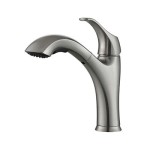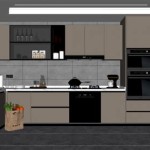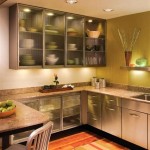Best Wood for Kitchen Cabinets: A Comprehensive Guide
Selecting the optimal wood for kitchen cabinets is a significant decision, influencing both the aesthetic appeal and the longevity of a kitchen design. The choice involves careful consideration of wood species, their respective characteristics, and how these factors align with budget constraints and design preferences. This article provides a comprehensive overview of commonly used wood types for kitchen cabinets, detailing their strengths, weaknesses, and suitability for various applications within a kitchen environment.
The durability of kitchen cabinets is paramount, given the high-traffic nature of the area and the constant exposure to moisture, temperature fluctuations, and potential impacts. Certain wood species offer greater resistance to these environmental stressors, ensuring that cabinets maintain their structural integrity and appearance over extended periods. Furthermore, the aesthetic qualities of wood, including grain patterns, color variations, and finishing options, contribute significantly to the overall style and ambiance of a kitchen.
Cost considerations are also an integral part of the selection process. Different wood species vary considerably in price, reflecting factors such as availability, harvesting practices, and processing requirements. Balancing the desired aesthetic and functional requirements with budgetary limitations is a key aspect of making an informed decision.
Hardwood vs. Softwood: Understanding the Core Differences
The terms "hardwood" and "softwood" are often used to categorize wood species, but these classifications are botanical, not necessarily indicative of the wood's actual hardness or density. Hardwoods typically originate from deciduous trees, which lose their leaves annually, while softwoods come from coniferous trees, which typically remain evergreen. While there are exceptions, hardwoods are generally denser and more durable than softwoods, making them a preferred choice for kitchen cabinets.
Hardwoods, such as maple, oak, cherry, and birch, offer superior resistance to dents, scratches, and other forms of wear and tear. They also tend to hold screws and fasteners more securely, resulting in more robust and long-lasting cabinet construction. The tighter grain patterns found in many hardwoods also contribute to a smoother, more refined finish, enhancing the overall aesthetic appeal of the cabinets.
Softwoods, such as pine and fir, are generally less expensive than hardwoods. They are also easier to work with, making them a popular choice for DIY projects or situations where intricate detailing is required. However, softwoods are more susceptible to damage and may require additional protective finishes to withstand the rigors of a kitchen environment. The lighter color and more pronounced grain patterns of softwoods can also be a stylistic consideration, lending a more rustic or informal feel to a kitchen design.
Popular Hardwood Options for Kitchen Cabinets
Several hardwood species are commonly used in kitchen cabinet construction, each offering a unique combination of aesthetic qualities, durability, and cost. Understanding the specific characteristics of these hardwoods is essential for making an informed decision that aligns with design preferences and functional requirements.
Maple: Maple is a popular choice for kitchen cabinets due to its hard, dense, and fine-grained texture. It offers excellent durability and resistance to scratches and dents, making it well-suited for high-traffic kitchens. Maple has a light, creamy color that can be easily stained or painted to complement various design styles. Its uniform grain pattern provides a smooth and consistent surface, making it ideal for modern or contemporary kitchens.
Oak: Oak is another widely used hardwood for kitchen cabinets, known for its strength, durability, and distinctive grain patterns. Oak is available in two main varieties: red oak and white oak. Red oak has a reddish tint and a more open grain pattern, while white oak has a more neutral color and a tighter grain pattern. Both varieties are highly resistant to wear and tear and can be stained to achieve a wide range of colors. Oak cabinets are often associated with traditional or transitional kitchen designs.
Cherry: Cherry is a premium hardwood prized for its rich, reddish-brown color and smooth, even grain. It is a relatively hard and durable wood, although it may be slightly more susceptible to scratches and dents than maple or oak. Cherry cabinets develop a richer, deeper patina over time, adding character and warmth to a kitchen. Cherry is often used in more formal or upscale kitchen designs.
Birch: Birch is a close relative of maple and shares many of its characteristics, including its light color, fine grain, and durability. Birch is generally less expensive than maple, making it a more budget-friendly option. It can be stained or painted to match various design styles and is well-suited for both modern and traditional kitchens.
Considering Softwood Options and Alternatives
While hardwoods are generally preferred for kitchen cabinets due to their superior durability, softwoods can be a viable option in certain situations, particularly when budget constraints are a primary concern. Additionally, engineered wood products, such as plywood and MDF (medium-density fiberboard), offer alternative solutions that combine affordability with acceptable performance characteristics.
Pine: Pine is a readily available and inexpensive softwood that is often used in rustic or country-style kitchens. Pine is relatively soft and prone to damage, but it can be protected with a durable finish. The knotty grain pattern and light color of pine cabinets can add a warm and informal touch to a kitchen design.
Plywood: Plywood is an engineered wood product made by layering thin sheets of wood veneer and bonding them together with adhesive. Plywood is dimensionally stable and resistant to warping or cracking, making it a good choice for cabinet boxes and shelves. It is typically less expensive than solid wood and can be veneered with a variety of wood species to achieve the desired aesthetic.
MDF: MDF is another engineered wood product made from wood fibers that are compressed and bonded together with resin. MDF is very smooth and consistent, making it an excellent surface for painting. It is also less expensive than solid wood and plywood. However, MDF is susceptible to water damage and should be used with caution in areas that are exposed to moisture.
When considering softwood options or engineered wood products, it is crucial to select high-quality materials and apply appropriate protective finishes to ensure adequate durability and resistance to moisture. Professional installation is also recommended to minimize the risk of damage and ensure proper alignment.
Ultimately, the best wood for kitchen cabinets depends on a confluence of factors, including budget, style preferences, and functional requirements. Careful consideration of these factors will lead to a durable and aesthetically pleasing kitchen that provides lasting value.

Best Wood For Kitchen Cabinets Trifection Remodeling Construction

What Are The Best Woods For Kitchen Cabinets In Tucson

Best Wood Types For Kitchen Cabinets Cabinet

Choosing The Best Wood For Kitchen Cabinets 9 Types Rosene Cabinet Door And Custom Interior Doors In Toronto Gta

The Best Wood Species To Use For Kitchen Cabinets

Kitchen Cabinet Woods 7 Of The Best Wood Species For Your Cabinets
:max_bytes(150000):strip_icc()/DesignbyNatalieKraiemPhotobyKirstenFrancis-c8c60d48cd3541a9bdb756a933aa3780-a21edbeb7f374a498dd8a5cfbb33cdd1.jpg?strip=all)
25 Kitchens With Light Wood Cabinets Sure To Impress

Kitchen Cabinet Painting Which Woods Are The Best To Paint Booth 7

What Wood Is Best For Kitchen Cabinets Tru Custom Woodworks

The Best Kitchen Cabinet Woods Custom Company








